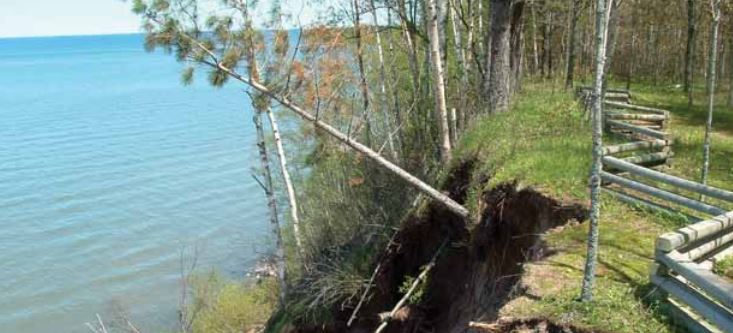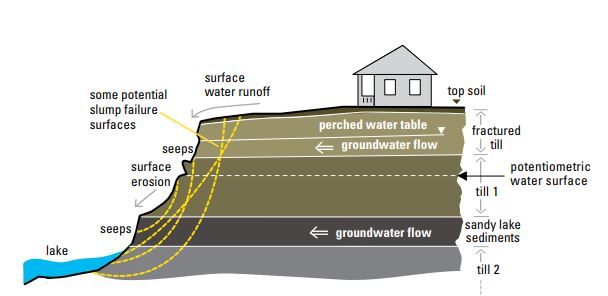
In this blog, Alan Lulloff (ASFPM) describes how stormwater and groundwater are connected, how they impact bluff stability, and the how management has changed over time.
Stormwater/Groundwater Connections and Bluff Stability
Managing stormwater and groundwater on coastal bluff properties is an important factor in maintaining a stable bluff. Spring weather brings increased runoff to Lake Michigan from melting snow and ice while spring and summer storms can drop large amounts of precipitation on a property. High lake levels can erode coastal bluffs from the outside in but increased groundwater can destabilize a coastal bluff from the inside out.
Alan Lulloff, Chief Scientist with the Association of State Floodplain Managers (ASFPM) Flood Science Center, describes how stormwater and groundwater are connected, how they impact bluff stability, and the how management has changed over time.
Alan Lullof is a professional engineer and certified floodplain manager. Prior to working with the ASFPM Flood Sciences Center, he spent 30 years with the Wisconsin DNR working on issues related to groundwater, floodplain management, and coastal erosion. He is the author of Managing Coastal Hazard Risks on Wisconsin’s Dynamic Great Lakes Shoreline, a report that describes coastal hazards in Wisconsin that includes an erosion hazard model ordinance.
Here are his answers to our questions about the connection between stormwater, groundwater, and bluff stability.
How do groundwater and surface water levels impact bluff failure?
Bluffs on the Great Lakes are comprised of a variety of materials laid down by the glaciers. The stability of bluffs is directly related to groundwater elevations and water in general. Water is like lubrication reducing the friction between the soil particles. Bluffs can stand without failing for long periods of times (even decades) and then can have a large section fail suddenly when groundwater lubricates the junction between two soil layers causing a large rotational failure (Figure 1).

Figure 1 shows a series of dotted lines along which sections of this coastal bluff could potentially fail and slide.
In what ways could stormwater be managed to prevent bluff slumping or failures?
The best way to limit the impact of stormwater on bluffs is to maintain natural drainage to the extent possible.
-
- Direct stormwater laterally to natural streams and creeks.
- Avoid constructing storm water detention ponds near bluffs.
- On individual lots homeowners should direct downspouts away from the bluff to the front of their lots.
- On-site waste disposal should be located as far as possible from the bluff.
- Direct stormwater to storm sewers where available.
- Pipes that direct stormwater down the face of bluffs are prone to failure due to the instability of the bluffs and should be avoided if possible.
Are management practices such as raingardens or porous pavements that allow infiltration of surface water to groundwater helpful or harmful to bluff stability?
These management practices can increase the amount of water in the soil column. Therefore, they should be avoided near unstable bluffs. Rain barrels are a better stormwater management practice that limits water to bluffs being saturated during a rainfall event. Capturing and using the rainwater after the rain event reduces the impact.
What is the idea of “no adverse impact” and how does it relate to bluff management?
No Adverse Impact is a principle promoted by ASFPM wherein property owners minimize their impacts on their neighbors and the environment. Examples include avoiding the construction of berms that back up water on neighboring properties or diverting stormwater that could destabilize a neighbor’s bluff. Constructing shore protection structures at the toe of bluffs can deflect wave energy increasing erosion on neighboring properties. If shore protection is absolutely necessary, it is best to work with neighbors to develop a regional solution.
In your professional experience, how have groundwater issues and bluff management changed with development, land use changes, and new management techniques?
Houses along the coast have gotten larger and the equipment used for grading areas above bluffs have gotten bigger. People on Great Lakes coasts often want to enhance their view so in some cases they cut back the top of the bluff allowing stormwater to flow over the top and down the face of the bluff. The roots of shrubs and small trees can help stabilize bluffs. Therefore, removing native vegetation to improve the view can destabilize a bluff. If a house cannot be adequately setback from an unstable bluff, modest-sized houses built with a crawl space instead of slab on grade can more easily be moved if necessary. The crawl space enables beams to be inserted for lifting the structure so it can be moved.
As an added bonus…
Alan shared how he thinks climate change will impact the relationship between stormwater and groundwater.
Rainfall intensity is predicted to increase with climate change. While the total amount of rainfall may stay the same the intensity is predicted to increase. This means that rainfall will occur in a shorter period of time overwhelming natural drainage systems. Stormwater drainage will be challenged causing more over land flow potentially destabilizing bluffs.
Images retrieved from University of Wisconsin Sea Grant Institute. (2012) Stabilizing Coastal Slopes on the Great Lakes, WISCU-G-05-003.
June 19, 2019 | By Lydia Salus, Coastal Resilience Project Assistant, Wisconsin Sea Grant




